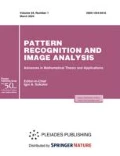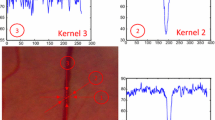Abstract
Diabetic retinopathy is one of the dangerous fundus diseases that leads to irreversible loss of vision. In the case of untimely or incorrect treatment, blindness occurs. Currently, laser coagulation is a common treatment method. An ophthalmologist uses a laser to apply a series of burns to the retina. The success of the operation depends entirely on the experience of the doctor. The automatic formation of a preliminary plan of coagulates allows us to solve a number of problems related to the operation, such as long manual placement of coagulates or adjustment of laser power. Thus, the probability of a doctor’s error is reduced, and the preparation time for the operation is significantly reduced. One of the key stages in the formation of the plan is the segmentation of the fundus image. This stage is carried out with the help of texture features, the calculation of which takes a long time. In relation to this, this study proposes high-performance algorithms for the segmentation of fundus images using CUDA technologies, which significantly speed up sequential versions and outperform parallel algorithms.





Similar content being viewed by others
REFERENCES
U. R. Acharya, E. Y. Ng, J. H. Tan, S. V. Sree, and K. H. Ng, “An integrated index for the identification of diabetic retinopathy stages using texture parameters,” J. Med. Syst. 36 (3), 2011–2020 (2012).
A. N. Amirov, E. A. Abdulaeva, and E. L. Minkhuzina, “Diabetic macular edema: Epidemiology, pathogenesis, diagnosis, clinical presentation, and treatment,” Kazan. Med. Zh. 96 (1), 70–74 (2015).
M. A. Anan’in, N. Yu. Ilyasova, and A. V. Kupriyanov, “Estimating directions of optic disk blood vessels in retinal images,” Pattern Recognit. Image Anal. 17 (4), 523–526 (2007).
M. A. Anan’in and N. Yu. Ilyasova, “Method for estimation of the directions of the optic disk’s vessels in fundus images,” Pattern Recognit. Image Anal. 15 (2), 496–498 (2005).
Yu. S. Astakhov, F. E. Shadrichev, M. I. Krasavina, and N. N. Grigorieva, “Modern approaches to the treatment of diabetic macular edema,” Oftal’mol. Vedomosti 4 (1), 59–69 (2009).
G. V. Bratko, V. V. Chernykh, and O. V. Sazonova, “On early diagnostics and the occurrence rate of diabetic macular edema and identification of diabetes risk groups,” Sib. Nauchn. Med. Zh. 35 (1), 33–36 (2015).
D. S. Kermany, M. Goldbaum, W. Cai, et al., “Identifying medical diagnoses and treatable diseases by image-based deep learning,” Cell 172 (5), 1122–1131 (2018).
I. I. Dedov, M. V. Shestakova, and O. K. Vikulova, “State register of diabetes mellitus in the Russian Federation: Status of 2014 and development prospects,” Diabetes Mellitus 18 (3), 5–23 (2015).
I. I. Dedov, M. V. Shestakova, and G. R. Galstyan, “Prevalence of type 2 diabetes mellitus in the adult population of Russia (NATION study),” Diabetes Mellitus 19 (2), 104–112 (2016).
A. V. Doga, G. F. Kachalina, E. K. Pedanova, and D. A. Buryakov, “Modern diagnostic and treatment aspects of diabetic macular edema,” Ophthalmology, Diabetes 4, 51–59 (2014).
K. Fukunaga, Introduction to Statistical Pattern Recognition (Academic Press, New York, 1972).
H. Gentillon, L. Stefańczyk, M. Strzelecki, and M. Respondek Liberska, “Parameter set for computer-assisted texture analysis of fetal brain,” BMC Res. Notes 9, 496 (2016).
M. Hajek, M. Dezortova, A. Materka, and R. Lerski, Texture Analysis for Magnetic Resonance Imaging (Med4publishing, 2006).
Yu. HeiShun, B. Tischler, M. M. Qureshi, J. A. Soto, S. Anderson, N. Daginawala, B. Li, and K. Buch, “Using texture analyses of contrast enhanced CT to assess hepatic fibrosis,” Eur. J. Radiol. 85 (3), 511–517 (2016).
N. Ilyasova, R. Paringer, and A. Kupriyanov, “Regions of interest in a fundus image selection technique using the discriminative analysis methods,” in Computer Vision and Graphics, ICCVG (2016), pp. 408–417.
N. Yu. Ilyasova, A. V. Kupriyanov, and R. A. Paringer, “The discriminant analysis application to refine the diagnostic features of blood vessels images,” Opt. Mem. Neural Networks 24 (4), 309–313 (2015).
N. Yu. Ilyasova, N. S. Demin, A. S. Shirokanev, A. V. Kupriyanov, and E. A. Zamytskiy, “Method for selection macular edema region using optical coherence tomography data,” Komp’yut. Opt. 44 (2), 250–258 (2020). https://doi.org/10.18287/2412-6179-CO-691
N. Yu. Ilyasova, A. S. Shirokanev, A. V. Kupriynov, and R. A. Paringer, “Technology of intellectual feature selection for a system of automatic formation of a coagulate plan on retina,” Komp’yut. Opt. 43 (2), 304–315 (2019). https://doi.org/10.18287/2412-6179-2019-43-2-304-315
Jyostna Devi Bodapati, Veeranjaneyulu Naralasetti, Shaik Nagur Shareef, Saqib Hakak, Muhammad Bilal, Praveen Kumar Reddy Maddikunta, and Ohyun Jo, “Blended multi-modal deep ConvNet features for diabetic retinopathy severity prediction,” Electronics 9 (6), 914 (2020). https://doi.org/10.3390/electronics9060914
M. Kernt, R. Cheuteu, and R. Liegl, “Navigated focal retinal laser therapy using the NAVILAS® system for diabetic macula edema,” Ophthalmologe 109, 692–700 (2012).
T. V. Kotsur, and A. S. Izmailov, “The effectiveness of laser coagulation in the macula and high-density microphotocoagulation in the treatment of diabetic maculopathy,” Oftal’mol. Vedomosti 9 (4), 43–45 (2016).
Kozak, I., and J. Luttrull, “Modern retinal laser therapy,” Saudi J. Ophthalmol. 29 (2), 137–146 (2014).
M. Ixcamey and C. Palma, “Diabetic macular edema,” Disease-a-Month 67 (5), 101138 (2021). https://doi.org/10.1016/j.disamonth.2021.101138
A. Mukhin, I. Kilbas, R. Paringer, and N. Ilyasova, “Application of the gradient descent for da-ta balancing in diagnostic image analysis problems,” in 2020 International Conference on In-formation Technology and Nanotechnology (ITNT) (IEEE Xplore, Samara, 2020), pp. 1–4.
M. D. Ober, “Time required for navigated macular laser photo coagulation treatment with the Navilas,” Graefes Arch. Clin. Exp. Ophthalmol. 251 (4), 1049–1053 (2013).
J. Odstrcilik, R. Kolar, R. P. Tornow, J. Jan, A. Budai, M. Mayer, M. Vodakova, R. Laemmer, M. Lamos, Z. Kuna, J. Gazarek, T. Kubena, P. Cernosek, and M. Ronzhina, “Thickness related textural properties of retinal nerve fiber layer in color fundus images,” Comput. Med. Imaging Graphics 38 (6), 508–516 (2014).
A. Septiarini, A. Harjoko, R. Pulungan, and R. Ekantini, “Automatic detection of peripapillary atrophy in retinal fundus images using statistical features,” Biomed. Signal Process. Control 45, 151–159 (2018).
A. S. Shirokanev, D. V. Kirsh, N. Yu. Ilyasova, and A. V. Kupriynov, “Investigation of algorithms for coagulate arrangement in fundus images,” Komp’yut. Opt. 42 (4), 712–721 (2018).
M. Strzelecki, P. Szczypinski, A. Materka, and A. Klepaczko, “A software tool for automatic classification and segmentation of 2D/3D medical images,” Nucl. Instrum. Methods Phys. Res. 702, 137–140 (2013).
M. Szczypiński, M. Strzelecki, A. Materka, and A. Klepaczko, “MaZda–A software package for image texture analysis,” Comput. Methods Programs Biomed. 94 (1), 66–76 (2009).
G. S. Tan, N. Cheung, and R. Simo, “Diabetic macular edema,” Lancet Diabetes Endocrinol. 5 (2), 143–155 (2017).
I. V. Vorobieva and D. A. Merkushenkova, “Diabetic retinopathy in patients with type 2 diabetes mellitus. Epidemiology, a modern view of pathogenesis,” Ophthalmology 9 (4), 18–21 (2012).
T. Y. Wong, G. Liew, and R. J. Tapp, “Relation between fasting glucose and retinopathy for diagnosis of diabetes: Three population-based cross-sectional studies,” Lancet 371 (9614), 736–743 (2008).
E. A. Zamytsky, A. V. Zolotarev, E. V. Karlova, and P. A. Zamytsky, “Analysis of the coagulates intensity in laser treatment of diabetic macular edema in a Navilas robotic laser system,” Saratov J. Med. Sci. Res. 13 (2), 375–378 (2017).
X. Zhang, J. B. Saaddine, and C. F. Chou, “Prevalence of diabetic retinopathy in the United States, 2005–2008,” JAMA 304, 649–656 (2010).
Funding
This work was funded by the Russian Foundation for Basic Research (project no. 19-29-01135) and the Ministry of Science and Higher Education of the Russian Federation within a government project of the Federal Research Center Crystallography and Photonics of the Russian Academy of Sciences.
Author information
Authors and Affiliations
Corresponding authors
Ethics declarations
COMPLIANCE WITH ETHICAL STANDARDS
This article is a completely original work by the authors, it has not been previously published, and it will not be published in other publications.
CONFLICT OF INTEREST
The authors state that they do not have a conflict of interest.
Additional information

Nataly Yurievna Ilyasova. Born 1966. Graduated with honors from Korolyov Samara State Aerospace University (SSAU) (1991). She received a Candidate’s degree (1997) and a Doctoral degree (2015) in Technical Sciences. She is a Senior Researcher at the Image Processing Systems Institute of the Russian Academy of Sciences–Branch of the FSRC Crystallography and Photonics RAS and a Professor at SSAU’s Technical Cybernetics subdepartment. Research interests: digital signals, image processing, pattern recognition, artificial intelligence, and biomedical imaging and analysis. Laureate of the regional prize in the field of science and technology on the topic “Computer systems for processing medical diagnostic images in medical institutions of the Samara region.” She is the author of more than 160 scientific papers, including 80 articles in the field of computer systems for analysis of diagnostic images, information systems for biomedical applications and 3 monographs published with coauthors. https://ssau.ru/english/staff/64603001-ilyasova-natalya-y

Alexandr Sergeevich Shirokanev graduated (2017) with a master’s degree in Applied Mathematics and Informatics. He is a postgraduate student of Samara University. Junior researcher at the Image Processing Systems Institute of the Russian Academy of Sciences–Branch of the FSRC Crystallography and Photonics RAS. Until 2017, he worked as an engineer at the Department of Technical Cybernetics at Samara University. Research interests: medical data mining, digital image processing, mathematical modeling, and numerical methods. He is the author of more than 40 publications in the field of intelligent analysis of fundus data to improve the quality of diagnosis and treatment of diabetic retinopathy. He won the Young Scientist competition. https://ssau.ru/english/staff/427263695-shirokanev-alexandr-s

Nikita Sergeevich Demin. Postgraduate student at Samara University and an Assistant of the Technical Cybernetics Department at Samara University, Russia. Graduated from Samara University in 2019 with a Master’s degree in Applied Mathematics and Informatics. Research interests: digital image processing, mathematical modeling, pattern recognition, and artificial intelligence. https://ssau.ru/english/staff/335805566-demin-nikita-s
Rights and permissions
About this article
Cite this article
Ilyasova, N.Y., Shirokanev, A.S. & Demin, N.S. Development of High-Performance Algorithms for the Segmentation of Fundus Images Using a Graphics Processing Unit. Pattern Recognit. Image Anal. 31, 529–538 (2021). https://doi.org/10.1134/S1054661821030135
Received:
Revised:
Accepted:
Published:
Issue Date:
DOI: https://doi.org/10.1134/S1054661821030135




